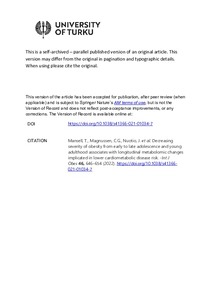Decreasing severity of obesity from early to late adolescence and young adulthood associates with longitudinal metabolomic changes implicated in lower cardiometabolic disease risk
Mansell Toby; Magnussen Costan G.; Nuotio Joel; Laitinen Tomi T.; Harcourt Brooke E.; Bekkering Siroon; McCallum Zoe; Kao Kung-Ting; Sabin Matthew A.; Juonala Markus; Saffery Richard; Burgner David; Saner Christoph
https://urn.fi/URN:NBN:fi-fe2022081153680
Tiivistelmä
Background
Obesity in childhood is associated with metabolic dysfunction, adverse subclinical cardiovascular phenotypes and adult cardiovascular disease. Longitudinal studies of youth with obesity investigating changes in severity of obesity with metabolomic profiles are sparse. We investigated associations between (i) baseline body mass index (BMI) and follow-up metabolomic profiles; (ii) change in BMI with follow-up metabolomic profiles; and (iii) change in BMI with change in metabolomic profiles (mean interval 5.5 years).
Methods
Participants (n = 98, 52% males) were recruited from the Childhood Overweight Biorepository of Australia study. At baseline and follow-up, BMI and the % >95th BMI-centile (percentage above the age-, and sex-specific 95th BMI-centile) indicate severity of obesity, and nuclear magnetic resonance spectroscopy profiling of 72 metabolites/ratios, log-transformed and scaled to standard deviations (SD), was performed in fasting serum. Fully adjusted linear regression analyses were performed.
Results
Mean (SD) age and % >95th BMI-centile were 10.3 (SD 3.5) years and 134.6% (19.0) at baseline, 15.8 (3.7) years and 130.7% (26.2) at follow-up. Change in BMI over time, but not baseline BMI, was associated with metabolites at follow-up. Each unit (kg/m2) decrease in sex- and age-adjusted BMI was associated with change (SD; 95% CI; p value) in metabolites of: alanine (-0.07; -0.11 to -0.04; p < 0.001), phenylalanine (-0.07; -0.10 to -0.04; p < 0.001), tyrosine (-0.07; -0.10 to -0.04; p < 0.001), glycoprotein acetyls (-0.06; -0.09 to -0.04; p < 0.001), degree of fatty acid unsaturation (0.06; 0.02 to 0.10; p = 0.003), monounsaturated fatty acids (-0.04; -0.07 to -0.01; p = 0.004), ratio of ApoB/ApoA1 (-0.05; -0.07 to -0.02; p = 0.001), VLDL-cholesterol (-0.04; -0.06 to -0.01; p = 0.01), HDL cholesterol (0.05; 0.08 to 0.1; p = 0.01), pyruvate (-0.08; -0.11 to -0.04; p < 0.001), acetoacetate (0.07; 0.02 to 0.11; p = 0.005) and 3-hydroxybuturate (0.07; 0.02 to 0.11; p = 0.01). Results using the % >95th BMI-centile were largely consistent with age- and sex-adjusted BMI measures.
Conclusions
In children and young adults with obesity, decreasing the severity of obesity was associated with changes in metabolomic profiles consistent with lower cardiovascular and metabolic disease risk in adults.
Kokoelmat
- Rinnakkaistallenteet [27094]
